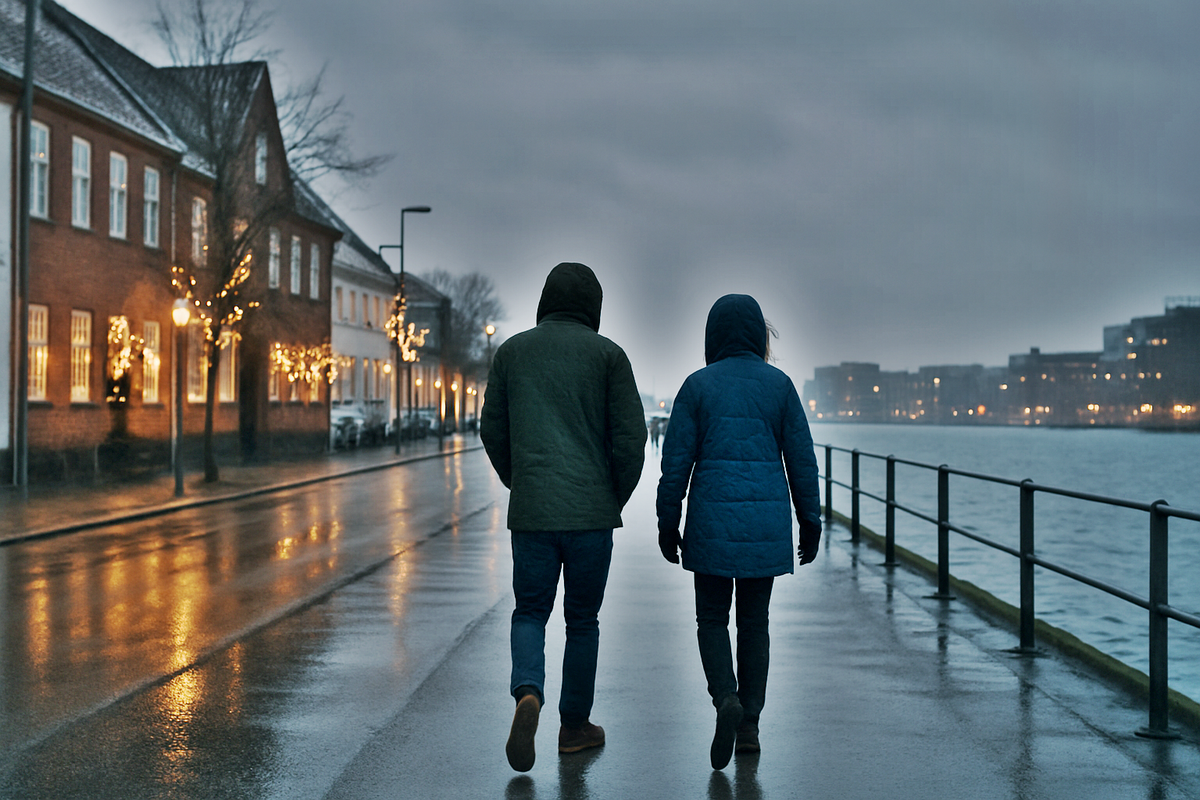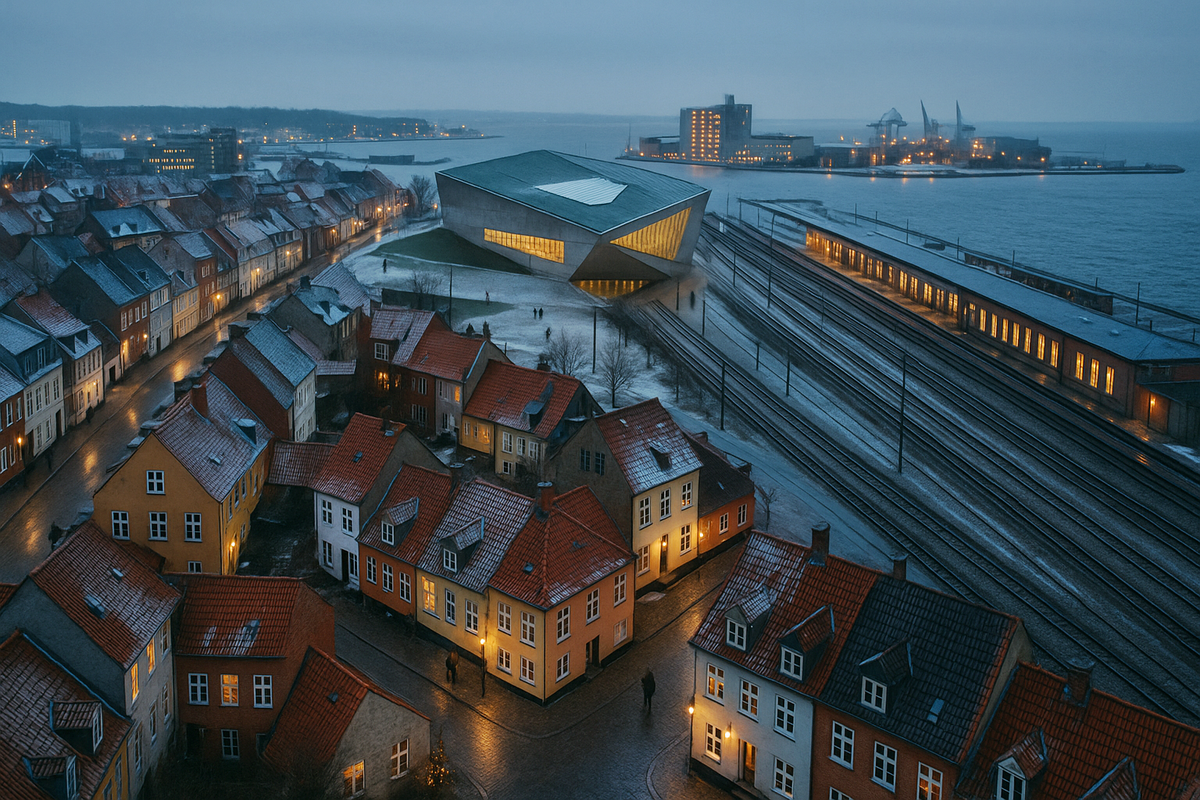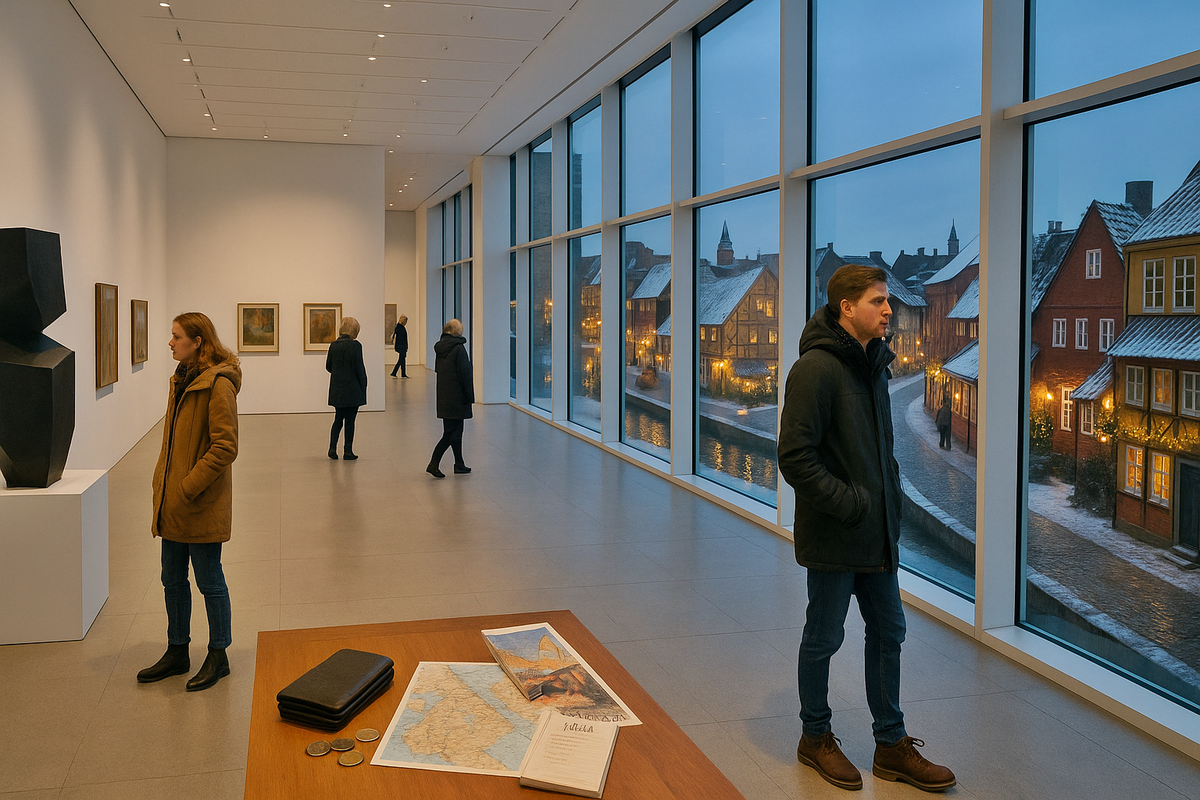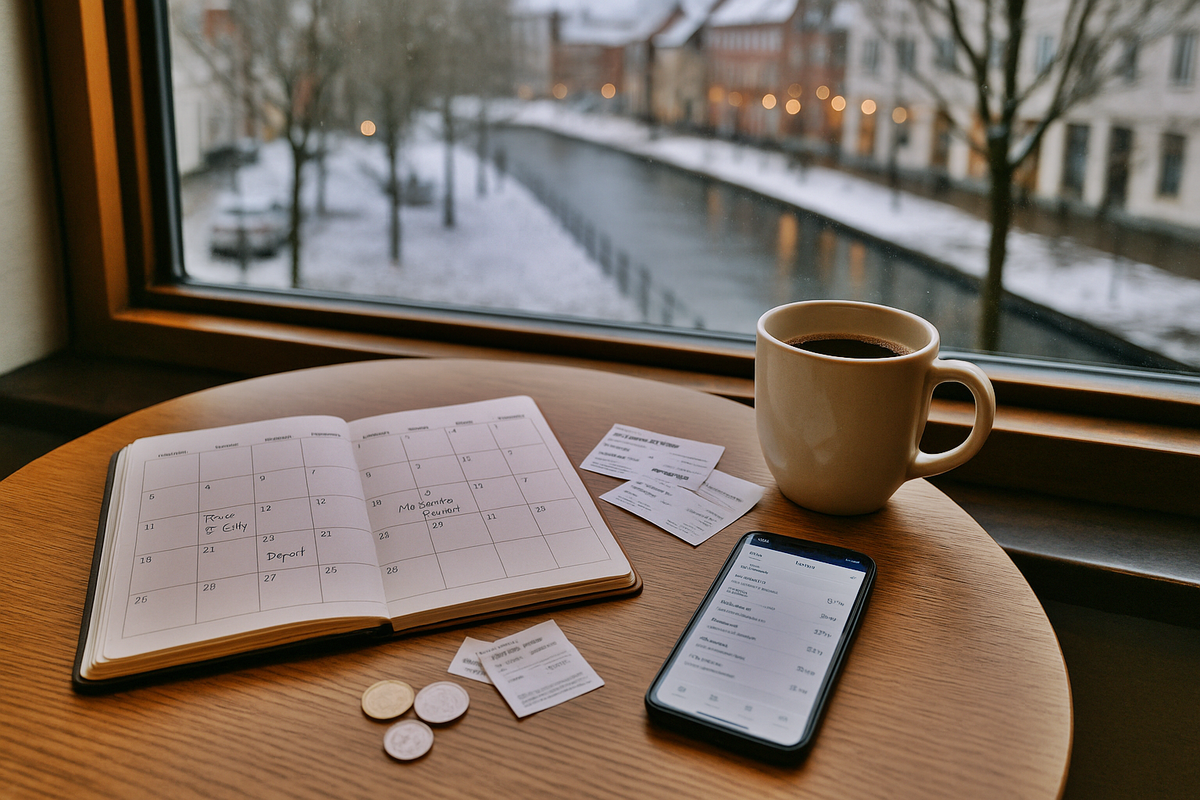🧳 Aarhus and Odense in winter: museum lights, Brandts and the spirit of Andersen
In winter, Denmark is not just Copenhagen and Tivoli. Aarhus and Odense are well worth a 2–3 night winter weekend break: compact centres, impressive museums and easy-to-follow walking routes.
Aarhus functions as a ‘second capital’: large museums, modern architecture and a waterfront, with most key points within walking distance of the train station.
Odense is ‘Andersen's city’ with a cosy old town, museums related to the writer, and the Brandts district, where you can conveniently combine art, cafés and shops.
Next, we'll look at the structure of the trip: where to stay, which areas to consider, which museums to build your day around, and how to choose your dates so you don't overpay or find yourself facing closed doors.
🌨️ Aarhus and Odense in winter: context, weather and 2-3 day itinerary

🧊 Realistic winter, not a postcard
The winter scenario for both cities is not ‘snowdrifts and fairs 24/7,’ but variable weather: around 0...+5 °C, wind from the water, possible rain or wet snow, short daylight hours.
Therefore, the basic logic of the route is as follows: street → museum/café → street, rather than hours of walking along the waterfront without any ‘warming points’.
🏙️ Why Aarhus
Aarhus is convenient because:
- the major museums (ARoS, Den Gamle By, Musikhuset, some of the shopping and restaurants) are concentrated around the centre and the train station;
- the Moesgaard Museum is easy to reach from the city and can be made into a separate ‘winter day’;
- the city gives the feeling of a ‘big’ but not overloaded metropolis.
🧭 Why Odense
Odense wins with its cosiness:
- H.C. Andersen House, his childhood home, related sites and the Møntergården museum form a complete ‘Andersen’ route through the old centre;
- The Brandts district adds contemporary art and a creative environment.
- Everything important is within walking distance, which is crucial in winter.
The focus of the trip is 2–3 nights in one city, without frequent transfers, with an emphasis on a comfortable pace and minimising logistical stress.
🏡 Areas to stay: where to live so that everything is within walking distance

🏙️ Aarhus: Midtbyen, Frederiksbjerg, Docklands
🧱 Midtbyen / Indre By — ‘maximum convenience’
- Walking distance to ARoS, the city hall, shopping, restaurants and the waterfront.
- Accommodation options: classic hotels, boutique hotels, apartment solutions.
- Pros: minimal transport, everything is ‘at hand’.
- Cons: higher price per night, especially on weekends and during events.
🌉 Frederiksbjerg — ‘quieter, but close to the station’
- The area is right behind the train station, with cafes, bakeries and local shops.
- It is a 10-15 minute walk to the centre and museums.
- Often slightly more affordable, with the same level of convenience.
🌊 Aarhus Ø / Docklands — ‘living by the water’
- A modern neighbourhood by the harbour: embankments, water views, new residential complexes.
- In winter, you need to take the wind into account, but the picture of ‘night lights by the water’ captivates many.
- The centre is within walking distance or a short trip by public transport.
🕍 Odense: Odense C, Brandts, Inner Harbour
🏘️ Odense C / historic centre
- The old centre, train station, H.C. Andersen House, Møntergården and the main pedestrian streets are within walking distance.
- A logical choice for a first visit in winter.
- Downside: during peak periods (December, festivals), demand and prices are higher.
🎨 Brandts / Brandts Klædefabrik
- The neighbourhood around the Brandts museum complex and the former textile factory.
- Cafés, galleries, small shops — convenient for winter ‘break → museum → coffee’.
- The old town and Andersen are a 10-15 minute walk away.
⚓ Inner Harbour / port area
- More modern buildings, views of the water, walking infrastructure.
- Focus on the ‘water’ view, but it is important to check the distance to the centre and bus connections.
Practical formula:
- Maximum convenience — Midtbyen in Aarhus and Odense C/Brandts in Odense.
- Price/location balance — Frederiksbjerg and neighbourhoods 1–2 stops from the centre.
- Quieter, but a little further away — residential areas around the centre with good transport links.
🖼️ Museums, lights and the ‘Andersen spirit’: what to build your itinerary around

🏛️ Aarhus: ARoS, Den Gamle By, Moesgaard
🌈 ARoS Aarhus Art Museum
- Contemporary art plus the ‘rainbow’ Your rainbow panorama on the roof — a view of the city and lights even in winter.
- Open all year round, it provides a ‘warm’ half-day under the roof.
🕰️ Den Gamle By
- An open-air museum-city where you can walk through ‘old Aarhus’ and different eras.
- In winter, it operates with shorter daylight hours, but the historical interiors and cafes inside provide shelter from the wind.
🗿 Moesgaard Museum
- A large archaeological and historical museum outside the city, in a forest area.
- In winter, it can be combined with a walk in the surrounding area; in snowy weather, the hill and roof create a ‘winter postcard’ scene.
📜 Odense: H.C. Andersen, Brandts, Møntergården
📚 H.C. Andersen House and the ‘Andersen Route’
- A modern museum space about Andersen's life and fairy tales + related objects (childhood home, sculptures, points in the centre).
- You can stretch it out to half a day, including a walk through the old centre with a ‘fairytale’ perspective.
🎭 Brandts / Brandts Klædefabrik
- Museum/galleries of contemporary art and photography + creative quarter around it.
- A typical winter scene: exhibition → coffee → short walk around the neighbourhood.
🏺 Møntergården and other museums
- Møntergården is a museum of the cultural history of Funen and Odense in an ensemble of historic buildings.
- Plus, small museums, themed exhibitions, libraries and cultural centres are good ‘warming spots’ in inclement weather.
The balance is simple: in Aarhus, focus on the ‘big’ museums and the large-scale city experience, in Odense — on ‘history in faces’, Andersen and intimate spaces.
📅 Weekend schedules and date selection: 2 or 3 days, when to go

🗓️ Typical format for 2 days
Day 1
- Morning: arrival and check-in (preferably before lunch so as not to lose daylight).
- Day: one large museum near your accommodation
- Aarhus: ARoS or Den Gamle By.
- Odense: H.C. Andersen House.
- Evening: walk around the city centre, dinner near the hotel, without complicated logistics.
Day 2
- Morning and afternoon: combined ‘museum + walk’ block
- Aarhus: second ‘anchor’ museum or trip to Moesgaard + short walk along the waterfront.
- Odense: Brandts + old town, small museums and cafés.
- Evening: early dinner, packing, return/transfer.
🗓️ 3-day format
Day 3 offers flexibility:
- Aarhus: a separate day for Moesgaard or for the ‘city without museums’ — cafés, ports, shopping area.
- Odense: Funen Village or just another quiet day in the centre and at the port.
🛎️ Dates to consider
- 24–26 December, 31 December and 1 January — some museums and cafés may be closed or have very limited opening hours; plan for a maximum of one attraction + walks on these days.
- Smart dates: December before Christmas (advent atmosphere), the ‘inter-holiday’ period, late January and February (fewer tourists, often lower prices).
Principle: it is better to take 3 nights on quiet dates than 2 nights on ‘peak’ dates with closed museums and inflated prices.
💰 Budget and booking tactics: how not to overpay

🏨 Accommodation: the area determines half of the cost
- The centre of both cities (Midtbyen/Indre By in Aarhus, Odense C/Brandts in Odense) is more expensive, but saves on transport and time.
- Moving one step away (Frederiksbjerg, residential areas around the centre) allows you to reduce the price while remaining within walking distance or a short bus ride away.
In winter (except for Christmas/New Year's Eve peaks and individual events), hotels and apartments often offer more favourable rates for early bookings and flexible cancellation terms.
🎟️ Museums and transport
It is logical to include the following in your budget:
- 2–3 major museums in each city (ARoS, Den Gamle By, Moesgaard; H.C. Andersen House, Brandts, Møntergården, etc.);
- local transport to museums outside the city (Moesgaard, the museum village near Odense, and taxis in bad weather if necessary);
- a ‘buffer’ for cafes and snacks, which in winter become part of the ‘warm up and recharge’ logic.
📌 Tactical rules
- Book in advance for dates around Christmas, New Year and school holidays.
- Compare weekends and weekdays: sometimes shifting one day to the right or left makes a noticeable difference in price.
- Prioritise the area rather than the size of the room: in winter, it is important to be able to leave the hotel and be in the city immediately, rather than having to travel 25-30 minutes by bus.
- Do not overload the programme: plan one ‘anchor’ activity per day + a walk, rather than rushing through a checklist.
✨ Final guideline: 2–3 days in Aarhus or Odense in winter is a budget-friendly city break if you choose the area and dates in advance and understand which museums are really ‘must-sees’ for you. Then the short daylight hours and weather will work in your favour, adding to the atmosphere of the trip.
❓FAQ
💬 Yes, both cities are great for a short winter city break: museums, compact centres and walking routes can be covered in 2–3 days without rushing.
💬 It is best to stay in Midtbyen or nearby (including Frederiksbjerg) so that you can walk to ARoS, Den Gamle By, the train station and the waterfront.
💬 Look for accommodation in Odense C or the Brandts area, then H.C. Andersen House, museums and cafes will be within walking distance.
💬 The minimum set is ARoS with the ‘rainbow’, Den Gamle By in the city and, if possible, a trip to Moesgaard Museum for a separate day.
💬 The basic route is built around H.C. Andersen House and the old centre, with the addition of the Brandts district and the Møntergården museum for a cosy ‘Andersen’ atmosphere.





0 comments
Log in to leave a comment